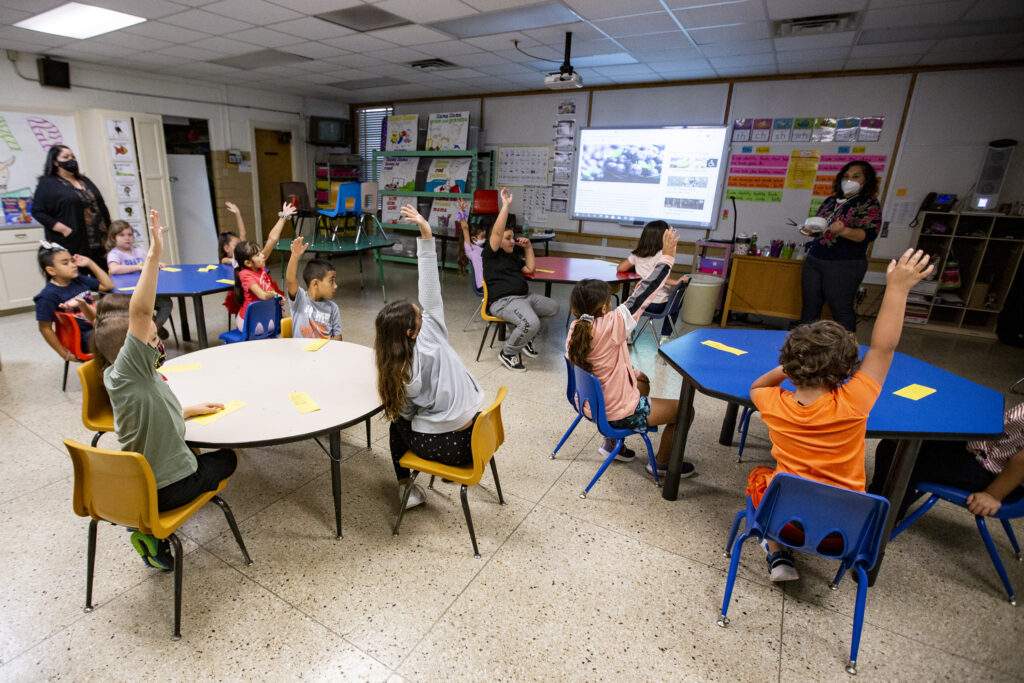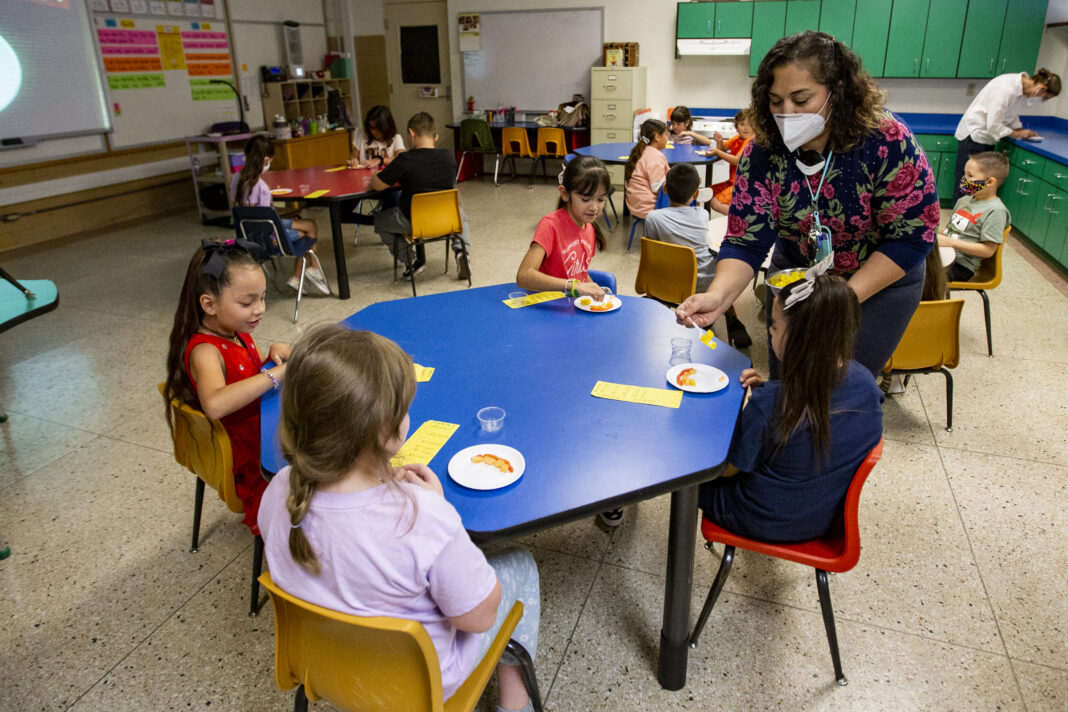Having seen the success of its Careers and Community program campus years ago, Zavala Elementary School wanted to revive it.
The kindergarten through second grade campus recently received a $3,000 grant from the Oliver Foundation to recreate it. Through after-school and in-class lessons on economics, math, language arts, fine arts and community education, students will operate a mini-society type of program. The program covers all areas of the curriculum and includes health, wellness and fitness.
Ultimately, the school is aiming for a mini town with businesses, peace keepers, community helpers, medical clinics, a court system and many of the same ingredients that make up a real-life city.
Some store fronts and supplies will be sponsored by area businesses, while others will need funding. The goal is for each student to have a job and purpose in the community.
Principal Tanya Galindo is hoping to get students from Career and Technical Education to build the storefronts.
The campus has about 400 students, Galindo said.
On a recent Wednesday, teacher Sandy Huertas presented a lesson on the benefits of fruits and vegetables and the colors of the rainbow.
Students were given small pieces of peppers and fruit to place on a paper plate in the shape of a rainbow. They also answered questions about the benefit of the produce by saying what it was good for, such as treating inflammation.
Adalyn Mata said she learned about reversible and non-reversible changes such as when you boil an egg, it can’t go back to its previous form.
Devin Compton said the lesson “felt good.”
“We learned how to eat healthy food …,” Compton said.
He added that he thinks healthy eating is something he’ll keep trying to do as he gets older.
Galindo said Huertas, the magnet school teacher, sees every student in the school throughout the week, so they all receive the same lessons.
She also has students who participate in the magnet, or choice, program who get an hour at the end of the day.
“We try to teach on a little bit of everything,” Huertas said.
She added that she tries to incorporate reading as well, for example. Huertas said the lessons seem to stick with the students.
“… I know me growing up, if it was hands on, I had fun especially I was able to taste it; I loved it and it was memorable for me ….,” she said.
Huertas noted that the students are still bringing up things from last year. One student found a seed in an orange and said they were going to plant it.
“They learn it and they remember it,” Huertas said.
She also wants to make sure the students understand the health aspects because it’s not just good for right now, but later in life, too, and it can impact their families.
Galindo said this program is something Zavala had been doing even before they were awarded the grant.
“I used to be a classroom teacher here before I was the principal. I was a teacher here and then an assistant principal. During that time, we were a micro-society campus. A micro-society is a mini society in which students open their own businesses. They have to write business plans; they have to interview for jobs; they have to purchase supplies; they create their own products; then they sell their products,” Galindo said.
“We had a health clinic; we had a court system. We had peace officers; lots of businesses; we had a workout center. So we’re doing a mini- version of that right now with community and career (initiative). Our ultimate goal is to become a micro-society campus again. These are lifelong skills that we’re teaching our students, so when they grow up and they are in high school, they are ready to get a job. They have those skills already,” Galindo added.
She said the school didn’t have a magnet program after school last year because of COVID, but this year they do. “So we’re starting all over with it. And Celeste Potter and the Education Foundation have helped and Dr. (Susan) Lara has helped with the grant writing. First Basin (Credit Union) adopted our campus, so they’re helping us with getting our storefronts going. They’re going to be coming in teaching our students basic banking lessons; talking about financial literature and literacy, and teaching them how to open a savings account and how to write checks because they’ll have to do that with our mini society that we’ll have on campus. And then we have JSA Architects; they also graciously have been helping us on our campus with what we need,” Galindo said.
She added that the students and parents are glad the Careers and Community program is back.
“… The kids are really excited because they get to experience these in person, and they get to, just like today with the rainbow activity, we’re learning about why these different fruits and vegetables are good for your body, then what it does for your body. We see it during lunchtime. They’re talking about what they’re eating and why they need to eat it; why it’s important to eat it, so that is great.”
“A lot of the students we have now, their parents were actually students that came to school here when I was a teacher here, so they remember micro-society and what it was like and how it helped them,” Galindo added.

Parents have said the magnet program helped them because they knew how to write checks, deposit money and balance their checkbooks.
They also knew how to count money and give change because they had worked at businesses at the school.
“The great thing with micro-society is students who are in our community and career classrooms after school they get paid to work, so they get Zavala money. They get paid and they have to go to the Zavala bank and cash their check. They have to pay bills because they have to pay back the loan for the business loan that they received.”
“We’ll also have a bank where students get to learn banking skills, so it helps with math and reading, science, social studies; all of it.”
And the students don’t even know it.
“… They’re just having a great time and it’s amazing to see what things our pre-k-second grade students come up with. They are so creative and they have so many great ideas,” Galindo said.
She added that prekindergarten through second are the grades to start at because they are teaching lifelong learning and social skills that they need to know.
“They’ll know how to interview for a job. They’ll know how to communicate with community members and then with their peers. These are all skills that we all need to know and learn,” she added.
A magnet campus offers extra enrichment courses.
“During magnet time, which is usually at the end of the day, those students that have enrolled for the magnet program, they get that extra enrichment, so ours is an extra hour at the end of the day,” Galindo said.
She added that the great thing about Zavala is that it has a choice teacher, Huertas, who is in her second year.
“She offers those classes throughout the day. Everyone gets to experience it, and then the after-school students get a little bit more of what she teaches now,” Galindo said.
She would like to have more neighborhood students stay for enrichment like they did in years past.
“If it’s going to be successful, we need to be able to invite all of our students, or the majority of them, to stay,” she added.
Galindo said the school also wants to get other campuses and teachers involved in ventures like planting a garden and having an art teacher from Bowie help Zavala students with art projects.
The University of Texas Permian Basin softball team also reads to the students.
“We’re the best-kept secret in town, I guess you could say. We’re a small campus. We have 400 students and we have a lot of great things happening and it’s time for everyone to know all the great things that are happening on our campus,” Galindo added.
She said the school also received another grant that will let them put out a monthly newspaper and have pen pals at Travis Elementary.
“We’re also going to have a post office and they’re going to have to write a letter. I talked to Miss (Amy) Russell (principal) at Travis and we want to do pen pals. We write letters to the older kids and then they write letters back and then our … postal workers will go and deliver mail,” Galindo said.
“We’re starting small, but we’re going to make it huge,” she added.



